You're sitting there staring at this (probably ancient alien origin) kanji character, and you have no idea what it means. Like nada. Nothing. Zilch. No matter how deep your probe your brain nothing will come out. Congratulations. You have successfully failed at identifying a kanji. Don't worry, though. It happens to the best of us. I mean, everyone except me, of course. Ever since using WaniKani I've basically become a kanji master (warning: obvious self-promotion alert), but whatever, you don't have to say I'm hoopy frood or anything on Twitter unless you really want to.
Anyways, I digress. Not being able to identify a kanji. It's a rough problem, though there's different levels to it. Sometimes the problem is easy to solve. Sometimes it's not. Let's start with easy and move our way down.
Identifying Typed-Out Kanji

This is by far the easiest. If you need to identify a kanji that's accessible via your computer you just copy it (that's ctrl+c or cmd+c after selecting said kanji) and then past it (that's ctrl+v or cmd+v) into the dictionary of your choice. For me, when it comes to simple stuff like this, my dictionary of choice is jisho.org.
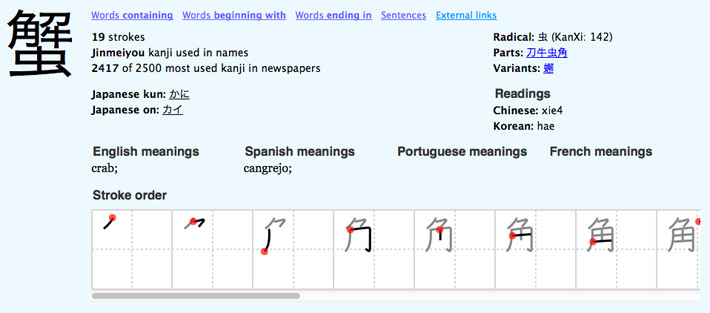
Upon pasting a kanji into the kanji section, you'll get lots of information about it, including it's meaning, reading, name-readings, number of strokes, and so much more. Basically, everything you need in order to identify a kanji.
How easy. Let's move on to something more exciting.
Identifying Handwritten Kanji
Here's where it starts to get fun. You have yourself some kanji that's not typed out. Perhaps it's a handwritten letter. Perhaps it's manga. Maybe it's Japanese subtitles. Whatever it is, you're not going to be able to copy/paste yourself to kanji identification victory. So now what do you do? There's a few options, some more free than others.
Jisho.org Radical Search
Back to Jisho, again. On Jisho there's a radicals search option. Now, keep in mind that the radicals that jisho uses may be different from the ones you've seen in other places. Jisho uses the official radicals plus a few extra. For the most part you should be able to find what you need to look up any kanji, though.
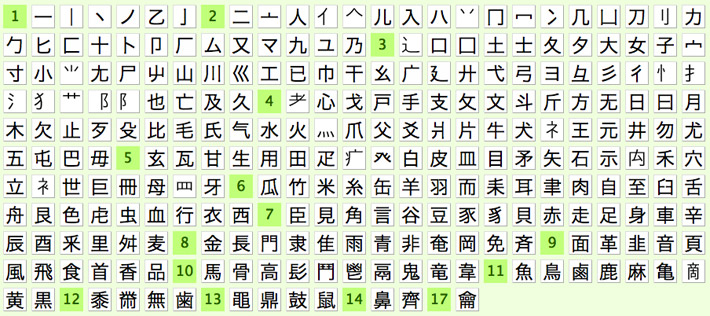
Depending on your level of Japanese, this may be fairly easy or somewhat difficult. Don't worry, with practice it gets easier and easier. Let's say you have the kanji 曜. This kanji is made up of a few radicals. The hardest part for beginners is knowing what constitutes a radical, though. The best way around this is to start off with something simple… something you know is a radical. For example, in the kanji 曜, 日 is a pretty obvious radical. It's simple, it's off on its own, and it's to the left, which is sometimes a good sign. Let's then click 日 on the radicals chart, then see what happens.
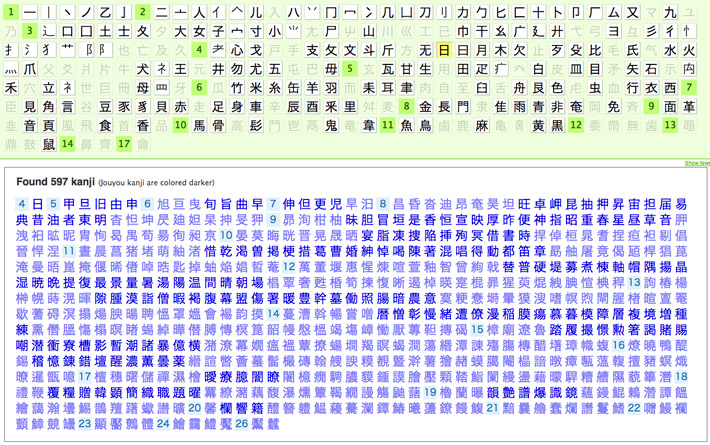
Wow, that's still a lot of results! But, you can see that we've narrowed down the radicals at least. Now you can see all the radicals that never show up in a kanji with the 日 radical have grayed out. This means there are fewer radicals to choose from, making it easier. At this point you have two options. 1) You can find the kanji in the list results down below (count the strokes and find the corresponding number to make the search faster) or 2) you can put in another radical. Let's do option number two, just for the sake of practice.
The next radical is up in the top right. It's there twice, but you only need to click the ヨ radical one time in jisho and it counts for both. When you do that, you'll find the kanji you're looking for. No other kanji uses the 日 and ヨ radicals together in one kanji, meaning it's the only result.

Click on the kanji and you'll find the droids you're looking for. That wasn't too bad, was it?
Physical Kanji Dictionary
There are times, though, when you don't have access to a computer or smartphone. When those end-times come, you may find yourself with a physical kanji dictionary and a kanji that you don't know.
To look up a kanji using a kanji dictionary, there are three strategies that you can use. They are:
- Look up the kanji via a radical
- Look up the kanji via its reading
- Look up the kanji via the number of strokes it has
All three of them can be somewhat tedious (especially number three) if you're used to using a computer, but 貧乏s can't be choosers, as they say. Let's go over each one:
1. Looking Up The Kanji Via A Radical
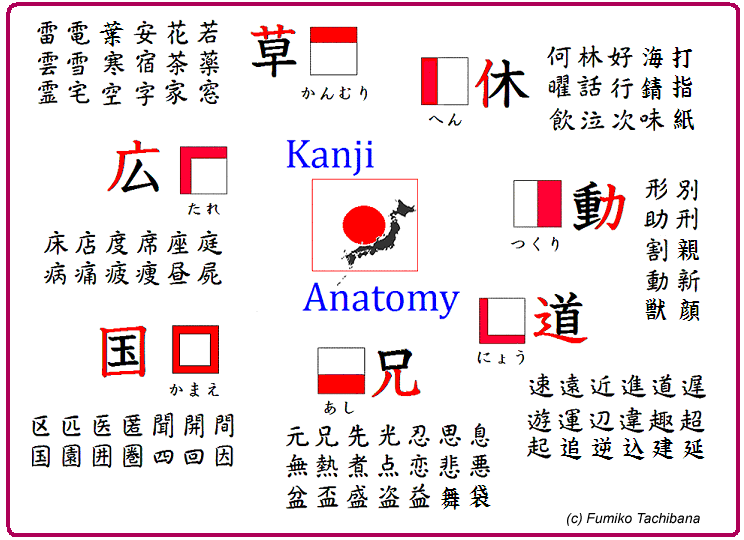
When it comes to paper kanji dictionaries, you only get one shot at choosing the correct radical. With every kanji there's a single official radical. Although this is completely different to how we teach it here (sorry for being confusing now), this is the way most people do it. In fact, when talking about "radicals" most normal people think of it this way. Just one radical per kanji, and its only real use is to look up said kanji in a paper dictionary (whereas we use the radicals to learn the meaning of the kanji and to create a more solid memory).
But how do you know what the radical is for a kanji? That's a good question, esteemed Tofugu reader. Usually you can identify it by looking for one of three sections:
- The left side of the kanji. For example, 泳 has the "water" radical on the left side, which is those three splashy drops.
- The top of the kanji. If something covers the entire top part of the kanji, that's probably the radical. For example, the bar on the top of 花 would be the radical used to look up that kanji.
- Something that surrounds a kanji. For example 病 the whole top left thing that makes up the outside of that kanji would be the radical.
- Or, sometimes the radical is just about anywhere. Seriously, radicals are evil sometimes. Look for a simple yet distinct part of the kanji. If you're lucky, this will be the radical you're looking for.
A lot of this also comes down to experience as well. The more you look up, the easier it will be to identify radicals. Most kanji dictionaries will list all the radicals somewhere and order them by stroke order. Then, you find the radical, see what page it starts on, then jump to that page in the dictionary. Once there, you flip through the kanji that use that radical and find the kanji you're looking for (usually these will be ordered in terms of stroke order as well).
For a list of these types of radicals, check here.
2. Looking Up The Kanji Via Its Reading
Also in a kanji dictionary is the ability to look up a kanji via its reading. In the case you know a kanji's reading (or are able to guess it based off the radicals it uses), you can look up a kanji in a kanji dictionary via the reading-lookup section. This will have various readings and then list out the kanji that use that reading. You can then simply scan through the listed kanji to find what you're looking for.
3. Looking Up The Kanji Via The Number Of Strokes It Has
Last but not least… okay, it's least… is looking up a kanji via the number of strokes it has. Most kanji dictionaries will have a section that just lists out every kanji with X number of strokes. Is looking up a kanji this way incredibly tedious? Yes. Is it good for when your radical radar fails you? Also yes. Hopefully you don't have to do this too often, because it's a pain, but it is there just in case you need it.
Write It In
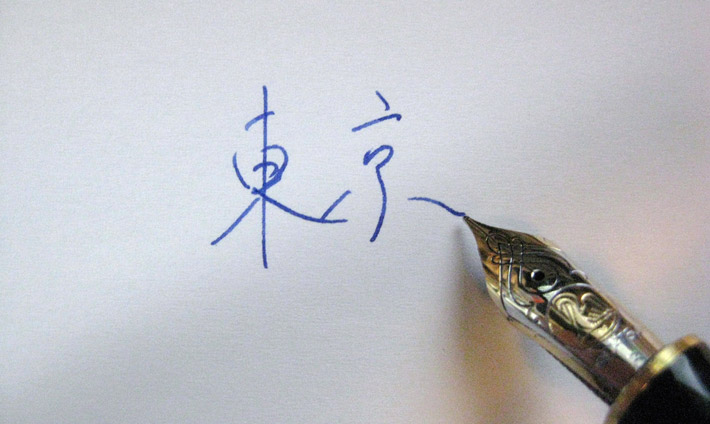
The last way to identify handwritten kanji is to write it in yourself. There is unicorn powered software out there that will take what you write and then try to identify it. Sometimes it works well, sometimes it doesn't work at all. It really depends on what you're using and how good your kanji looks. Let's look at a few options, though this certainly isn't all that's available.
1. Ben Bullock's Handwritten Kanji Recognition
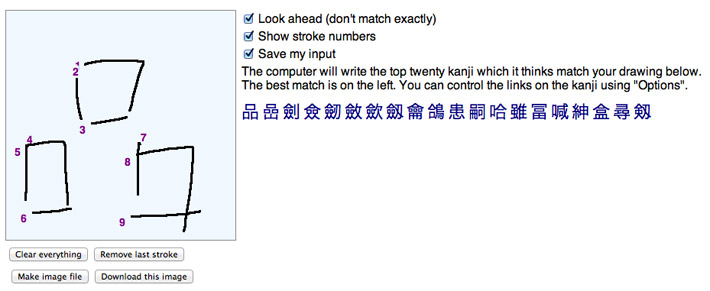
This website lets you write in a kanji with your mouse. It actually doesn't do too bad of a job figuring out what you're writing, so long as you don't butcher the kanji too badly. Stroke order is taken into account too, so be sure you know the basic stroke order rules. One particularly nice feature is the "look ahead" check box. This means it'll spit out kanji that you could be writing well before you're done writing it. For example, you can see I was writing 品 in the box, but kanji like 嵒 also come up, just because I could have been writing that kanji too (but the best result, 品 still shows up first).
Visit: Ben Bullock's Handwritten Kanji Recognition website
2. Kanji Sonomama Rakubiki Jiten
If you happen to have a Nintendo DS, this is a pretty sweet "game." Well, actually it's a kanji dictionary, but whatever. Besides just being a dictionary, it also lets you write in kanji to look up what it is you're looking for. Using the stylus and the stylus pad, this is actually really good experience, definitely one of the best "write in kanji" apps out there.
It is however a Japanese game (will still work on your non-Japanese DS) so it's harder to come by. You can get it on Amazon or Play-Asia (currently sold out). If you already have a DS of some kind this is cheaper than shelling out for a "real" electronic dictionary, though less full-featured.
3. iPhone, iPad
You can add new input keyboards onto your iPhone or iPad in the settings section. Just go to Settings > General > Keyboard > International Keyboard. Although it's not a Japanese input, technically, adding the Chinese Handwriting keyboard will allow you to actually write in any kanji using your finger. Then, when you write it in you'll be able to input it into whatever app you're writing on (let's say Notepad for this example). This is a nice easy way to identify a kanji you don't know if you're an iPhone owner. Just copy the kanji you've written into a Japanese dictionary and you'll have your answer.
Can you do something like this on Android? I don't know, so put tweet or email us if you do!
4. Electronic Japanese Dictionary
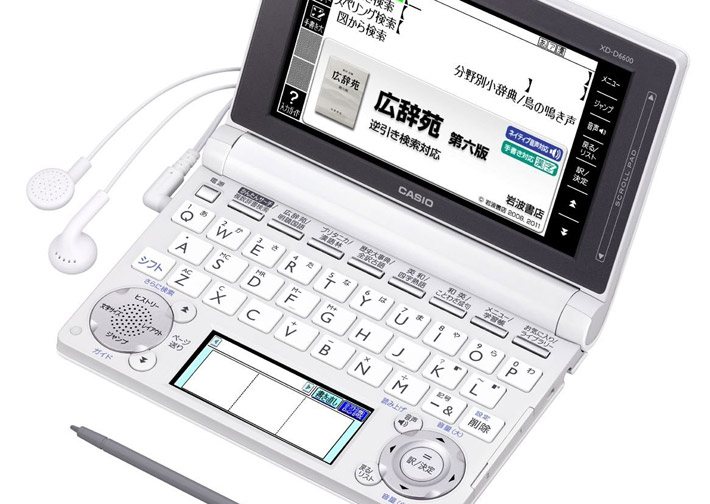
Many people also love their electronic kanji dictionaries. If you're serious about studying Japanese, you'll want one of these (many people say). I don't totally agree, and I think most people can live without, but if you're in the market for an electronic Japanese dictionary, you can consider getting one that has a stylus that lets you write in kanji, kind of like with Kanji Sonomama (up above) but fancier.
With these strategies, you should be able to identify just about any (legible) kanji out there, whether it's written down or typed down. But why stop there? Why not skip looking them up and learn how to figure out how to read them WITHOUT a dictionary?!
If you study kanji for long enough you'll begin to see patterns emerge. At first, they won't make too much sense and you'll think it's pure luck. You'll make a couple of connections and say "Hey! Nice! This made it easier to remember this kanji. Lucky me." Then, you'll go about your life as if everything was as it seems. What if I told you that you could have learned the readings of these kanji more quickly had you realized from teh start that these readings weren't just a coincidence? Did you know that there are actually radicals that are designed to show you the reading of a particular kanji?
Not all kanji has this reading compound, however. Apparently 67% of the joyo kanji have this phonetic compound radical inside of them, though that doesn't mean they're always helpful to you, it just means one of these radicals exists there. Let's first take a closer look at how you can find these "phonetic compounds."
The Anatomy Of A Kanji
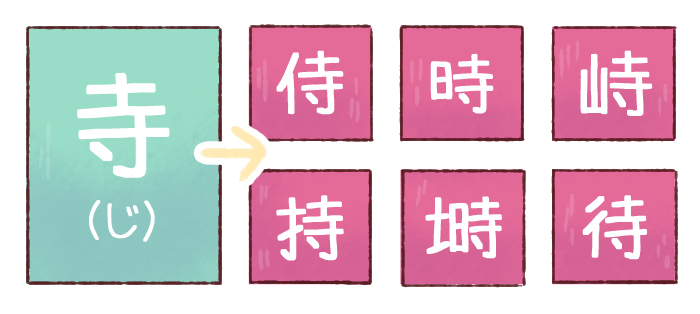
A standard kanji is made of a couple of parts (and sometimes some garbage). The left side / top is usually the "classifier radical." This is the radical that you can use to look up the kanji in a kanji dictionary. Sometimes it may even give a hint to the meaning of a kanji, though this is pretty hit or miss (mostly miss). The right side is usually what's known as the "phonetic compound." This portion has a specific reading attached to it. If you see this phonetic compound, you can sometimes guess the reading of the kanji. Sometimes by learning one phonetic compound's reading you can know how to read six or seven other kanji that contain it.
Now there are exceptions… tons of them, unfortunately.
First of all, sometimes the phonetic compound is on the left side, and not the right. This happens when the classifier radical is one of those classifier radicals that normally gets put on the right side. Anyways, you'll have to watch out for these.
Secondly, not all kanji have a phonetic compound inside of them. Like I mentioned earlier, only 67% of them have it, and they're not particularly useful. Of the ones that do have a phonetic compound, around 25% have readings that aren't consistent and are irregular. Even the ones that are fairly consistent with their readings have exceptions. Basically, this technique is at best a way to guess the reading of a kanji and nothing more. Still, something is better than nothing. Just imagine if you're taking the JLPT and you're on the kanji section. This sort of thing will help you get a few extra answers correct.
Phonetic Compounds And Their Kanji
To find the phonetic compounds, I sat down with a kanji dictionary going through all the possible readings in the back index. After spending about a half hour going through these one by one, I realized that someone else has probably done all the work for me. Thank goodness, someone had. Luckily for me, a Hiroko Townsend of San Diego State University put in a lot of work into her thesis, listing these out for everyone to enjoy. Thanks Hiroko! You're a boss.
Here are the radicals that contain fairly consistent phonetic compounds. There are some exceptions (not listed below), but in general they're pretty straightforward. If you learn the phonetic radical / kanji in the left side column then you know the readings for all the kanji to its right. For some kanji that's only slightly useful. For others, you learn the readings of a lot of kanji.
| Radical | Reading | Kanji |
|---|---|---|
| 几 | き | 机, 肌, 飢 |
| 亡 | ぼう | 忙, 忘, 盲, 荒, 望, 妄 |
| 干 | かん | 汗, 肝, 奸, 刊, 岸 |
| 己 | き | 起, 記, 紀, 忌 |
| 工 | こう | 紅, 空, 虹, 江, 攻, 功, 肛 |
| 及 | きゅう | 吸, 級, 扱 |
| 士 | し | 仕, 志, 誌 |
| 方 | ほう, ぼう | 肪, 坊, 紡, 防, 妨, 房, 謗, 傍, 芳, 訪, 放 |
| 中 | ちゅう | 忠, 沖, 仲, 虫, 狆 |
| 化 | か | 花, 貸, 靴 |
| 反 | はん | 版, 板, 坂, 飯, 販, 叛 |
| 分 | ふん | 粉, 紛, 雰 |
| 半 | はん | 伴, 絆, 拌, 判 |
| 白 | はく | 伯, 拍, 泊, 迫, 舶, 狛, 柏, 箔, 珀 |
| 皮 | ひ | 彼, 被, 疲, 被, 披 |
| 付 | ふ | 府, 符, 附, 俯 |
| 包 | ほう | 抱, 泡, 胞, 砲, 飽, 咆 |
| 可 | か | 河, 何, 荷, 苛, 呵, 歌 |
| 古 | こ | 居, 固, 故, 枯, 個, 湖, 箇, 沽, 姑, 苦 |
| 生 | せい | 姓, 性, 星, 牲, 惺 |
| 正 | せい | 征, 政, 症, 整, 性, 牲 |
| 司 | し | 伺, 詞, 嗣, 飼 |
| 且 | そ | 粗, 祖, 狙, 阻, 組 |
| 旦 | たん | 但, 胆, 疸, 担 |
| 令 | れい | 冷, 鈴, 零, 領, 齢, 鈴 |
| 立 | りゅう | 竜, 滝, 粒, 笠, 龍 |
| 申 | しん | 神, 伸, 呻, 押, 紳 |
| 召 | しょう | 招, 沼, 昭, 紹, 詔, 照 |
| 安 | あん | 案, 按, 鞍, 鮟 |
| 同 | どう | 洞, 胴, 桐, 恫, 銅, 洞, 筒 |
| 寺 | じ | 侍, 持, 時, 塒, 峙 |
| 旬 | じゅん | 洵, 殉, 恂 |
| 各 | かく | 格, 喀, 閣, 額 |
| 圭 | けい | 掛, 桂, 畦, 珪, 罫, 鮭, 硅 |
| 糸 | けい | 系, 係, 繋 |
| 結 | けつ | 潔 |
| 光 | こう | 恍 |
| 交 | こう | 校, 絞, 狡, 較, 郊, 効, 咬 |
| 共 | きょう, こう | 供, 恭, 洪, 哄 |
| 次 | し | 姿, 諮, 資 |
| 成 | せい | 盛, 誠, 筬, 城 |
| 朱 | しゅ | 株, 珠, 殊, 蛛 |
| 我 | が | 峨, 蛾, 餓, 俄, 鵞 |
| 甫 | ほ | 浦, 捕, 哺, 匍, 補, 蒲, 輔, 舗 |
| 見 | けん | 硯, 蜆, 現 |
| 辰 | しん | 唇, 振, 賑, 震, 娠 |
| 肖 | しょう | 宵, 消, 硝 |
| 弟 | てい | 第, 剃. 涕 |
| 廷 | てい | 庭, 挺, 艇 |
| 良 | りょう | 郎, 浪, 朗, 狼, 廊 |
| 直 | ちょく, しょく | 植, 埴, 殖, 稙 |
| 長 | ちょう | 張, 帳, 脹 |
| 非 | ひ | 悲, 緋, 誹, 鯡, 琲, 扉 |
| 朋 | ほう | 崩, 棚, 硼 |
| 果 | か | 課, 菓, 踝, 顆 |
| 官 | かん | 棺, 管, 館 |
| 奇 | き | 崎, 埼, 椅 |
| 其 | き | 期, 欺, 棋, 基, 旗 |
| 金 | きん | 欽, 錦, 銀 |
| 采 | さい | 彩, 菜, 採 |
| 青 | せい | 清, 靖, 精, 晴, 請, 情, 鯖, 静 |
| 昔 | しゃく | 借, 惜, 錯 |
| 尚 | しょう | 常, 裳, 掌 |
| 昌 | しょう | 娼, 唱, 菖, 晶 |
| 禺 | ぐう | 遇, 寓, 隅, 偶 |
| 扁 | へん | 編, 偏, 篇, 蝙 |
| 則 | そく | 側, 測, 惻 |
| 相 | そう | 想, 箱, 霜 |
| 湘 | しょう | 廂 |
| 莫 | ばく | 摸, 膜, 漠, 博, 縛, 幕 |
| 高 | こう | 縞, 稿, 藁 |
| 曹 | そう | 遭, 槽, 糟 |
| 曽 | そう | 贈, 僧, 憎, 増 |
| 童 | どう | 撞, 憧, 瞳 |
| 義 | ぎ | 儀, 議, 犠, 蟻, 艤 |
Uses a radical from obsolete Japanese
| Radical | Reading | Kanji |
|---|---|---|
| 孝* | こう | 孝, 老, 考 |
| 径** | けい | 径, 経, 軽, 怪, 茎 |
| 乍 | さく | 作, 昨, 窄, 酢, 搾 |
| 低** | てい | 低, 底, 抵, 邸, 抵 |
| 券* | けん | 券, 巻, 圏, 拳 |
| 根** | こん | 根, 痕, 恨, 懇, 墾 |
| 退 | たい | 腿 |
| 峡** | きょう | 峡, 狭, 挟 |
| 浅** | せん | 浅, 銭, 践 |
| 珍** | しん | 診, 疹, 参 |
| 峰** | ほう | 峰, 逢, 縫, 蜂, 蓬 |
| 俊** | しゅん | 俊, 峻, 悛, 逡, 竣, 浚 |
| 通** | つう | 通, 桶, 痛 |
| 険** | けん | 険, 験, 検 |
| 過 | か | 渦, 堝, 鍋, 蝸, 窩, 禍 |
| 福** | ふく | 福, 副, 複, 幅, 富, 蝠 |
| 滴** | てき | 滴, 適, 敵 |
| 壁* | へき | 壁, 癖 |
| 燥* | そう | 燥, 操, 藻 |
* remove the bottom radical component
** remove the left side radical component
That right there is approximately 100 kanji/radicals that, if you learn the reading of them, you can guess the reading of around 500 total kanji. That's around 1/4 of the joyo kanji list. Not a bad shortcut! I think one issue is that a lot of people don't know that this little trick exists. Just by knowing that you can do this, you'll begin to notice these patterns showing up in your own kanji learning. This will help to accelerate your kanji learning by a considerable amount in the long run.
So, if you're studying kanji, go through this list and start making the connections. What phonetic compounds do you already know? Now, see what other kanji there are to the right that you know. See how it all sort of makes sense? Kanji isn't as insane as people tend to think, though it's still super complicated no matter how you look at it. You'll spend a lot of time learning the kanji (even if you're using, say, WaniKani), but things like this will win you some extra time.
Good luck studying that kanji thing!
